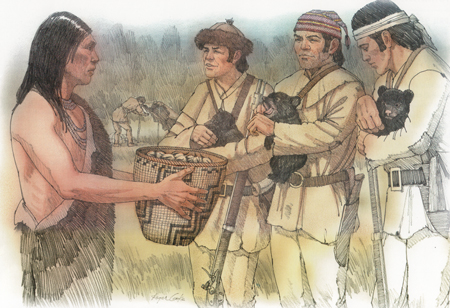Close Call on the Marias
Along with Sergeant Patrick Gass and Private John Collins, Windsor helped recover three orphaned grizzly bear cubs of a sow they killed on a hunt in early April 1806. According to Lewis, they traded the cubs to some coastal Indians, who, “fancyed these petts and gave us wappetoe in exchange for them.”
God god! Captain what shall I do?” Richard Windsor cried out. He and five other men, with Lewis in the lead, were returning down the Marias River after a reconnaissance trip to determine whether it or the other branch was the one they should follow to reach the Rockies. They were very cautiously making their way along the face of a bluff above the Marias on “a narrow pass of about 30 yards in length,” when Private Windsor slipped and fell in the wet clay soil—locally known as “gumbo”—and his right arm and leg were hanging over the edge, 90 rocky feet above the water. Only a moment before, Lewis had saved himself from a similar fall by using his espontoon to dig in and hang on. Immediately, Lewis recalled:
altho’ much allarmed at his situation I disguised my feelings and spoke very calmly to him and assured him that he was in no kind of danger, to take the knife out of his belt behind him with his wright hand and dig a hole with it in the face of the bank to receive his wright foot which he did and then raised himself to his knees; I then directed him to take off his mockersons and to come forward on his hands and knees holding the knife in one hand and the gun in the other this he happily effected and escaped.
Thus passed one of the expedition’s most harrowing moments for Windsor, a journeyman hunter who, aside from one episode of drunkenness at Camp Dubois, put in his time quietly.
More Trail Adventures
On 26 May 1805 after Lewis noted “Our hunters had killed two of the Bighorned anamals since I had left them.” He named the nearby creek Windsor’s creek perhaps in tribute to Windsor being one of the hunters. It is now Cow Creek in Blaine County, Montana and is only a few miles up river from where the Nez Perce crossed in 1877 while fleeing General Miles of the U S Army.
Assigned to Nathaniel Pryor‘s detail to take horses to Canada to trade for supplies, Windsor awoke to brief but likely intense fear on the night of July 26, 1806. The horses had been stolen the previous night, and now the four men were asleep after their first day of floating down the river two bull boats. In the wee hours of the morning a wolf bit one of Pryor’s hands, then turned on the just-awakened Windsor. Thereupon, Shannon shot it.
Life After the Expedition
In 1807, Windsor joined several Corps of Discovery veterans in Manuel Lisa‘s expedition to build Fort Manuel, a fur post on the Yellowstone River at the Bighorn’s mouth.[1]Larry E. Morris, The Fate of the Corps: What Became of the Lewis and Clark Explorers After the Expedition (New Haven: Yale University Press, 2004), 39. He worked safely from Lisa’s Bighorn post for two or three years, then returned to Missouri. He rejoined the army and served until 1819. Clark, in 1825-1828, recorded that Windsor lived along the Sangamon River in Illinois.
Notes
| ↑1 | Larry E. Morris, The Fate of the Corps: What Became of the Lewis and Clark Explorers After the Expedition (New Haven: Yale University Press, 2004), 39. |
|---|
Experience the Lewis and Clark Trail
The Lewis and Clark Trail Experience—our sister site at lewisandclark.travel—connects the world to people and places on the Lewis and Clark Trail.
Discover More
- The Lewis and Clark Expedition: Day by Day by Gary E. Moulton (University of Nebraska Press, 2018). The story in prose, 14 May 1804–23 September 1806.
- The Lewis and Clark Journals: An American Epic of Discovery (abridged) by Gary E. Moulton (University of Nebraska Press, 2003). Selected journal excerpts, 14 May 1804–23 September 1806.
- The Lewis and Clark Journals. by Gary E. Moulton (University of Nebraska Press, 1983–2001). The complete story in 13 volumes.


